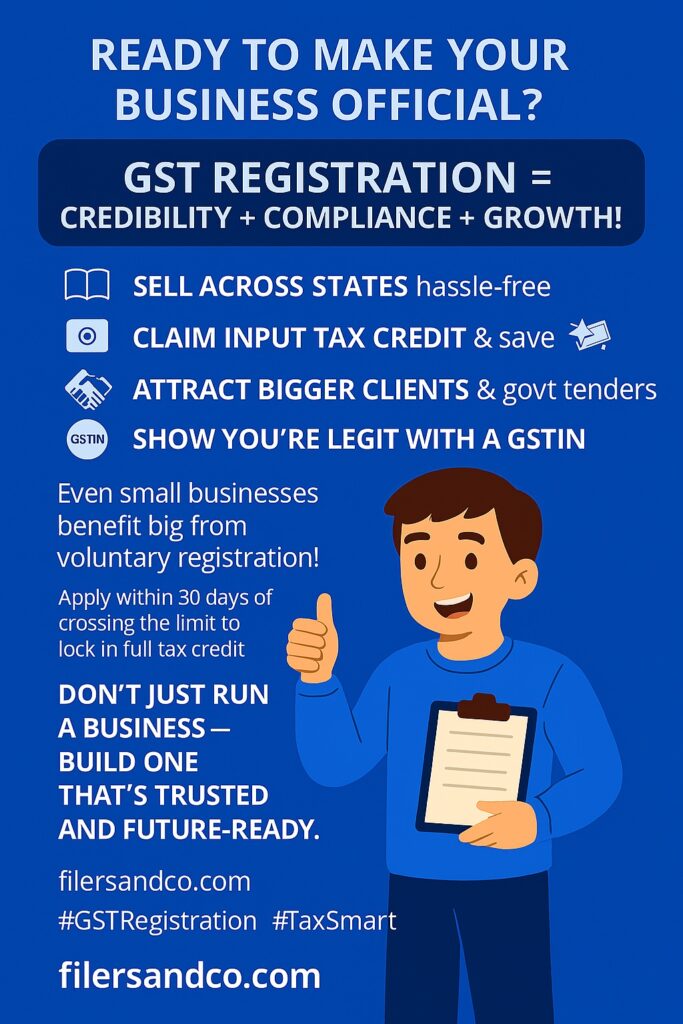
Goods and Services Tax launched on 1st July 2017 is a significant indirect tax reform in India that consolidates various taxes like excise duty, service tax, VAT, CST, luxury Tax, Entertainment Tax and Entry Tax.
GST is a destination-based tax, a value added tax applied to the supply, which includes the manufacture or sale of goods and the provision of services. It provides a comprehensive and continuous chain of tax credits throughout the supply chain, from the producer/service provider to the retailer and ultimately to the consumer. Each supplier in the supply chain can claim a credit for the GST paid on their purchases, offsetting against the GST they owe on the goods and services they supply. As a result, only the final consumer bears the GST charged by the last supplier in the supply chain, with offset benefits at all previous stages.
GST avoids tax on tax or cascading of taxes since it taxes only the value added at each stage of the supply chain.
Applicability/Eligibility
Every supplier of goods or services is required to obtain registration in the State or UT from where he makes the taxable supply, if his aggregate turnover exceeds the below mentioned limits:
| State | Engaged in Supply of Goods (Exclusively) | Engaged in Supply of Services or Supply of Goods and Supply of Services Both | |
| Manipur, Mizoram, Nagaland and Tripura | 10 Lakhs | 10 Lakhs | |
| Puducherry, Uttarakhand, Meghalaya, Arunachal Pradesh, Telangana and Sikkim | 20 Lakhs | 20 Lakhs | |
| All Other States including Assam, Jammu and Kashmir and Himanchal Pradesh | 40 Lakhs | 20 Lakhs | |
Note: Assam, Himachal Pradesh, Jammu and Kashmir are also special category state.
Types of GST:
- CGST- Levied by Central Government on Intra state supplies
- SGST-Levied by State Government on Intra State Supplies
- IGST-Applies on the Inter State Supplies
Registration:
An entity shall apply within 30 days of becoming liable to obtain GST Registration, i.e., within 30 days of crossing the threshold limit.
What if you failed to apply within 30 days, You will be granted registration from the date on which you applied for registration.
For example: If you cross the threshold limit in 1st January and you apply within 30 days you will be granted registration from 1st January, on the other hand, if you for registration on 2nd February, the date of registration will be 2nd February.
GSTIN:
GSTIN- GST Identification Number is assigned to every GST Registered Entity, each taxpayer is assigned a state-wise PAN-based 15-digit Goods and Services Taxpayer Identification Number (GSTIN).
Let’s Discuss Some Important GST Returns:
GST Return is a form that every entity with a GSTIN must file. There are 22 types of GST Returns, out of them, only 11 GST returns are active, 4 suspended, and 8 view-only in nature. The number and types of GST return that a business/professional must file is based on the type of taxpayer registered.
GSTR -1: Return furnished to report details of all outward supply of goods and services made. Due dates of filing of GSTR -1 are as follows:
- 11th of Every Month- If the annual aggregate turnover is more than Rs. 5 Crore or the entity has not opted for QRMP scheme.
- 13th of Every Month- If the entity has opted for QRMP scheme.
GSTR-2: The data is auto-populated based on data filed by the corresponding suppliers in their GSTR-1 returns. GSTR-2A is a view-only dynamic GST return relevant for the recipient or buyer of goods and services. It contains the details of all inward supplies of goods and services i.e.; purchases made from GST registered suppliers during a tax period.
GSTR-2B: It is an auto generated read only statement containing the details of eligible ITC. It is made available to the recipient of goods or services for every month.
GSTR-3B: GSTR-3B is to be filed by all normal taxpayers registered under GST. The sales and input tax credit details must be reconciled with GSTR-1 and GSTR-2B every tax period before filing GSTR-3B. Due dates of filing GSTR-3B are:
- 20th of the succeeding month- If the annual aggregate turnover is more than Rs. 5 Crore or the entity has not opted for QRMP scheme.
- 22nd /24th of the succeeding month- If the entity has opted for QRMP scheme.
Late filing of returns may result in payment of interest or penalty by the registered person.
QRMP Scheme:
The Central Board of Indirect Taxes & Customs introduced Quarterly Return Filing and Monthly Payment of Taxes (QRMP) scheme under Goods and Services Tax to help small taxpayers whose turnover is less than Rs.5 crores. The QRMP scheme allows the taxpayers to file GSTR-3B on a quarterly basis and pay tax every month. A registered person who is required to furnish a return in GSTR-3B, and who has an aggregate turnover of up to Rs.5 crore in the preceding financial year, is eligible for the QRMP Scheme. Further, in case the aggregate turnover exceeds Rs.5 crore during any quarter in the current financial year, the registered person shall not be eligible for the scheme from the next quarter.
RCM and Composition Scheme
Reverse Charge Mechanism (RCM)
Under RCM, the recipient of goods or services—not the supplier—is liable to pay GST. It’s used in cases like:
- Purchases from unregistered dealers
- Certain notified goods/services (e.g., legal services, transport by GTA)
- Services via e-commerce platforms
The recipient must self-invoice and pay the tax directly to the government. They can usually claim Input Tax Credit (ITC) on this, subject to conditions.
Composition Scheme
This is a simplified GST scheme for small taxpayers with turnover up to:
- ₹1.5 crore for goods
- ₹50 lakh for services
Instead of regular GST rates, they pay a fixed percentage of turnover:
- 1% for manufacturers/traders
- 5% for restaurants (non-alcohol)
- 6% for service providers
They can’t collect GST from customers or claim ITC, and they file quarterly payments (CMP-08) and an annual return (GSTR-4).
Input Tax Credit:
ITC in GST enables business businesses reduce their tax liabilities by claiming GST Credits on GST paid for business related purchases, For Example: The tax payable on Output is Rs.1000 and tax paid on input (purchases) is Rs. 300. The net tax liability will be Rs. 700.
GST ON Export/Import:
The export of goods or services is considered as a zero-rated supply. GST will not be levied on the export of any kind of goods or services.
All the supplies of goods and services made as imports into India is treated as Inter State Supply (IGST)
E-Invoicing:
E- Invoicing is mandatory for businesses with a turnover of more than Rs. 5 Crore. Under the electronic invoicing system, an identification number will be issued against every invoice by the Invoice Registration Portal (IRP), managed by the GST Network.
All invoice information gets transferred from this portal to both the GST portal and the e-way bill portal in real-time. Therefore, it eliminates the need for manual data entry while filing GSTR-1 returns and generation of part-A of the e-way bills, as the information is passed directly by the IRP to the GST portal.
E-Way Bill:
E-Way Bill is basically a compliance mechanism where person causing the movement of goods uploads the relevant information prior to commencement of movement of goods and generates e-way bill on GST Portal in Form GST EWB 01. So, it is an electronic document generated on GST Portal evidencing the movement of goods. Upon generation of e- way bill, a unique E-way Bill Number is made available to supplier, recipient and the transporter on the common portal.
GST Annual Return:
GSTR-9: GSTR-9 is the annual return that most businesses registered under India’s Goods and Services Tax (GST) system must file. It’s like a yearbook for your GST activity—summarizing all the monthly or quarterly returns (like GSTR-1, GSTR-3B, etc.) filed during the financial year.
Here’s what it typically includes:
- Details of outward and inward supplies (sales and purchases)
- Input tax credit (ITC) claimed and reversed
- Taxes paid and payable
- Any adjustments or reconciliations
It’s mandatory for regular taxpayers whose annual turnover exceeds ₹2 crore, and the due date is usually 31st December following the end of the financial year.
If you’re a composition taxpayer, you’d file GSTR-9A instead. And if your turnover crosses a certain threshold (currently ₹5 crore), you may also need to file GSTR-9C, which includes a reconciliation statement and audit certification.
GSTR-9C: GSTR-9C is a reconciliation statement that must be filed by GST-registered taxpayers in India whose annual turnover exceeds ₹5 crore. It acts as a bridge between your audited financial statements and the annual GST return (GSTR-9).Here’s what it includes:
- Reconciliation of turnover declared in GSTR-9 with audited financials
- Reconciliation of tax paid and input tax credit (ITC) claimed
- Disclosure of any additional tax liability
- Certification by a Chartered Accountant or Cost Accountant
As of the latest updates, the due date for filing GSTR-9C for FY 2022–23 is 31st March 2025, provided you’re availing the late fee waiver benefit.
It’s a crucial compliance step to ensure your GST filings align with your books of accounts. Want help understanding how to prepare it or what documents you’ll need?
Benefits of GST Registration:
GST (Goods and Services Tax) registration offers several advantages, especially for businesses looking to grow and operate transparently. Here are some key benefits:
- Legal recognition: It officially identifies your business as a supplier of goods or services, which builds credibility with customers and partners.
- Input tax credit: You can claim credit for the GST paid on purchases, which reduces your overall tax liability and avoids the cascading effect of taxes.
- Interstate trade: Registered businesses can freely supply goods or services across state borders without restrictions.
- Competitive edge: Being GST-compliant can make your business more attractive to larger clients who prefer dealing with registered vendors.
- Simplified compliance: The GST system has streamlined tax filing and payment processes through a unified online portal, making it easier to manage taxes.
- Eligibility for government tenders: Many government contracts require GST registration as a prerequisite.
- Access to composition scheme: Small businesses can opt for this scheme to pay tax at a lower rate and reduce compliance burden.
Even if your turnover is below the GST Threshold limit, voluntary GST Registration can provide some benefits like
- Claiming ITC for the GST paid on purchases
- Can get wider market access as many large businesses and government agencies prefer to work with GST Registered vendors
- Can engage in interstate sales, because GST Registration is mandatory for inter state sales
- Helps creating professional image, seemed as compliant and helps build trust with customers and suppliers
Challenges: GST registration, while essential, can be a bit of a maze—especially for small businesses. Common hurdles include complex documentation requirements, such as mismatched PAN or Aadhaar details, and errors in uploading address or bank proofs. Technical glitches on the GST portal and delays in Aadhaar authentication often led to rejections or repeated follow-ups. For first-timers, even selecting the correct business type can be confusing, and the fear of legal scrutiny or audits may discourage voluntary registration altogether.




